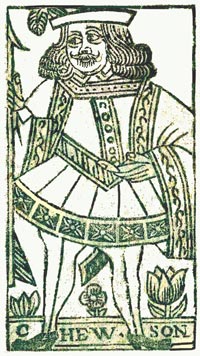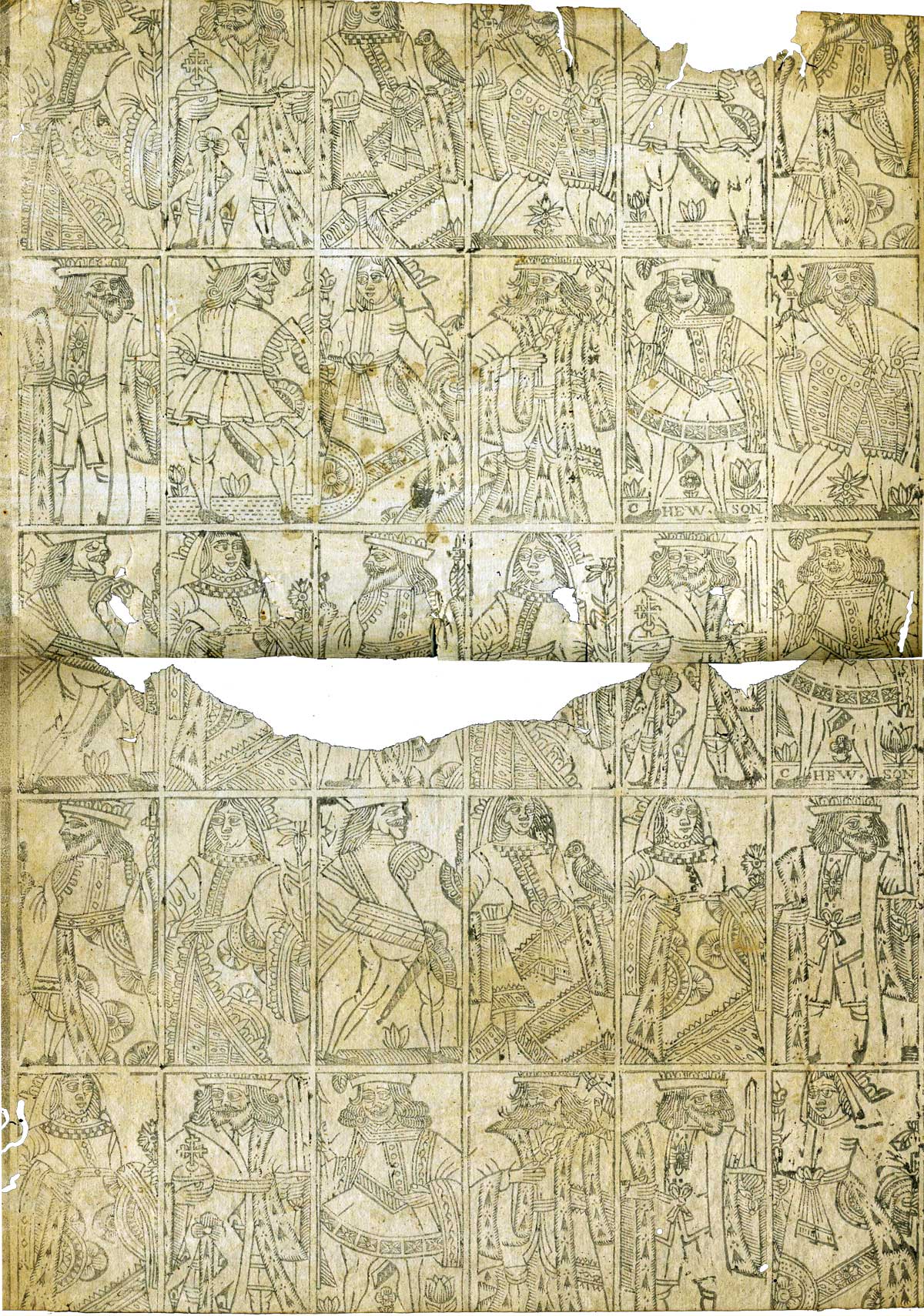Hewson
Antique English woodblock playing cards by a card maker named C. Hewson, mid-17th century.

Antique English playing cards by C. Hewson
Perhaps the best known early English playing card maker is known as “C. Hewson”.
However, there may never have been such card-maker. There are no references to anyone of that name in the Worshipful Company records, no adverts referring to him, nothing. It seems to be a name given to the Jack of Clubs in the wake of a non-standard pack of the late 17th century in which the JC is the historical figure, Cobbler Hewson, the regicide [here].
In this example, the standard English woodcut courts are not as misformed or distorted as they became later, and preserve features relating to the original French designs from which they derive. For example, the plants in the background of the Jacks, the Queens holding a bird or more elaborate flowers and the King of Hearts holding a battle axe, as well as a generally more realistic appearance, all gradually succumbed to a sort of industrial deterioration over time.

Above: antique standard English playing cards by a card maker named C. Hewson, mid-17th century. Images courtesy www.plainbacks.com→
Further specimens can be seen on the British Museum website: here►
Images in slideshow gallery (right): 1) Jack of Clubs by C. Hewson, mid-17th century. 2) Jack of Spades by anonymous manufacturer, possibly Thomas Lynne, who operated in Cripplegate, London in the 1630s, image courtesy of Lord & Lady Edward Manners, Haddon Hall. Photo by Ken Lodge. 3) Title page of new book "English card-makers and their wood-block cards: a classification of their distinguishing features with a particular focus on the period 1790-1830" by Ken Lodge and Paul Bostock which is now available direct from the authors.
To order copies of the book "English card-makers and their wood-block cards: a classification of their distinguishing features with a particular focus on the period 1790-1830" by Ken Lodge and Paul Bostock, contact Ken Lodge by email: k.lodge111@btinternet.com
The cost is £38 + postage. Postal rates are as follows:
First (UK): £2.38* |
Second (UK): £2.01* |
Europe (Air): £6.60 |
* if you would prefer a padded envelope, the cost is £3.20 (1st) + 70p for the envelope or £2.80 (2nd) + 70p for the envelope (UK orders only). | Overseas (USA etc): £10.15 |
Australasia: £10.75 |
REFERENCES
Lodge, Ken: The Standard English Pattern (second revised and enlarged edition), Bungay, Suffolk, 2010
Lodge, Ken: A fascinating find at Haddon Hall, published in ‘The Playing-Card’, journal of the IPCS, vol.43 no.1 pp.30-32.

By Simon Wintle
Member since February 01, 1996
I am the founder of The World of Playing Cards (est. 1996), a website dedicated to the history, artistry and cultural significance of playing cards and tarot. Over the years I have researched various areas of the subject, acquired and traded collections and contributed as a committee member of the IPCS and graphics editor of The Playing-Card journal. Having lived in Chile, England, Wales, and now Spain, these experiences have shaped my work and passion for playing cards. Amongst my achievements is producing a limited-edition replica of a 17th-century English pack using woodblocks and stencils—a labour of love. Today, the World of Playing Cards is a global collaborative project, with my son Adam serving as the technical driving force behind its development. His innovative efforts have helped shape the site into the thriving hub it is today. You are warmly invited to become a contributor and share your enthusiasm.
Related Articles

Batman® playing cards
Batman playing cards published by InterCol of London 1989.

Can You Believe Your Eyes?
“Can You Believe Your Eyes?” playing cards featuring visual illusions & other oddities.

Pastime Playing Cards for the Blind
The “Pastime” Playing Cards for the Blind manufactured by Goodall & Son Limd., c.1910.

Songs with Flute accompaniment
Eighteenth century English engraved cards with music for voice and flute.

Love Tests
Vintage novelty “Love Test” cards of a slightly saucy nature but all in good fun!

International pattern from Russia
Colourful international pattern cards from Russia sold in Latvia.

Ben 10 playing cards
Characters from the American animated television science fantasy series Ben 10.

Doctor Who Trump Card Game
Game for two players in which Doctor Who and the Legendary Legion join battle with the Alien Hordes....

Justice playing cards
Ethical concepts in a deck produced by Riccardo Conturbia’s Passione Playing Cards Ltd.

Heráldica Castanyer No. 16
Strange variant of international pattern cards for poker or bridge.

Disney’s Aladdin playing cards
Characters from the 1992 Disney film Aladdin.

2011 Worshipful Company Pack
Celebrating the bicentenary of the birth of Charles Dickens, with characters adapted from drawings b...

Jockey Club de Buenos Aires
Spanish-suited pack by Chas Goodall & Son Ltd for the Jockey Club, Buenos Aires.

New interest in old games
Games once fashionable are now eclipsed by quicker gratifications.

Polygo™
Cards of irregular, four-sided shape for playing word and colour games as well as more traditional o...

Treasures from the Bodleian Library
Rare books, manuscripts, music scores, portraits, maps, gospels, chronicles and other valuable artef...
Most Popular
Our top articles from the past 28 days




